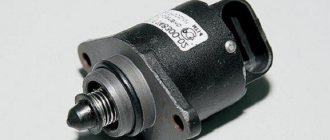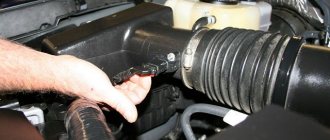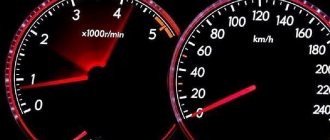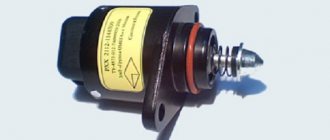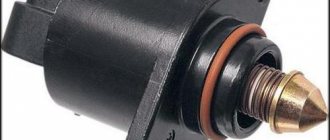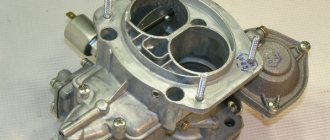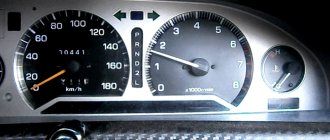VAZ 2107 is the latest model of the Zhiguli, available with rear-wheel drive. In essence, this is the “Five”, which has increased engine power, improved design and exterior. The car was produced with various engine sizes, ranging from 1.45 to 1.7 liters. Until 2006, the “Seven” had a carburetor engine, but during the transition to Euro-2, the designers developed and installed a forced fuel injection system, i.e. injectors.
With the introduction of injection engines, car enthusiasts felt positive changes in the operation of these cars.
All mechanisms are subject to wear and tear and fail over time. The forced injection system is no exception; during operation it acquires a number of malfunctions.
In VAZ 2107 cars, the engine sometimes stops working while idling. It happens that the engine stalls, but after starting it works properly. After some time this happens again. This means that the breakdown exists and will still have to be fixed. The reason is most likely in the throttle assembly, or more precisely in the idle air controller (IAC).
Purpose and design of the idle speed controller.
The idle speed regulator is designed to regulate the amount of atmospheric air entering through the bypass channel (bypass) into the suction manifold when the engine is idling. The main channel is closed by the throttle valve.
The regulator is a DC electric motor. It has two windings on the stator and a rotor with permanent magnets. The rotor is connected to the rod by a lead screw. At the end of the rod there is a valve that closes the hole in the bypass. Power is supplied either to the first or to the second stator winding. At the same time, the rotor rotates in one direction and then in the other, extending or retracting the rod and the valve with it using a screw.
First, let's look at the most common problems.
- Without gasoline (diesel). As paradoxical as it may seem, drivers often forget to monitor the fuel level in the tank.
- On diesel engines (especially in winter), frozen fuel can cause the car to start and stop almost immediately (but, as a rule, diesel VAZs are very rare).
- The quality of gasoline at gas stations is often alarming, so when refueling a car with low-quality fuel, you may encounter the problem of a stalled engine. If there is not enough bad gasoline, you can dilute it with good gasoline. But if the tank is full, it is best to drain the surrogate so as not to cause harm.
- Worn wires and old (faulty) spark plugs are also very common causes.
- Engine compression, or rather the lack thereof, can cause a situation where the engine barely has time to “recover.” But this is already a very serious breakdown, the appearance of which is accompanied by a host of other symptoms, which are simply impossible not to notice while operating the car.
An interesting article about biofuel from ordinary sawdust, more details.
Operating principle of IAC.
SPVT (Forced fuel injection system) has its own “brain”, which receives all the information from the sensors, processes it and issues commands to the actuators for the optimal functioning of the internal combustion engine (ICE). This “brain” is called a controller or ECU (Electronic Control Unit). IAC refers to the actuators controlled by the controller.
At the moment of start-up, the regulator opens a hole in the bypass. Air enters the suction manifold through it. The engine starts running. As the engine warms up, the valve closes, reducing the air supply. The speed is stabilized to a minimum.
When the throttle valve is opened, the main flow of air is supplied to the engine through the main channel. In this case, the regulator closes the hole in the bypass. To smoothly control the idle air control, the ECU receives additional information from sensors: throttle position, air flow, crankshaft position and tachogenerator.
When additional loads on the engine arise (turning on a radiator fan, heater, etc.), the regulator opens a hole in the bypass. This makes it possible to maintain power and prevent engine failures.
What carburetors are installed on the VAZ 2105
All carburetor installations equipped with the VAZ 2105 are focused, first of all, on minimizing fuel consumption. Of course, AvtoVAZ engineers throughout the history of the “five” experimented with the equipment of the car in order to identify the most effective mechanisms.
Over the years, various modifications of carburetors were installed on the VAZ 2105. All of them had both their advantages and disadvantages, which the drivers themselves often had to identify while driving.
Modification of DAAZ
The Dimitrovgrad Automobile Unit Plant (DAAZ) has launched the production of carburetor units under license from Weber. The main quality of DAAZ products is ease of operation and repair. The production of all parts necessary for repair and replacement was established, so if necessary, the driver could easily buy the necessary components and independently carry out the work of adjusting the carburetor.
DAAZ carburetors provided the car with increased speed characteristics, since the new nozzle system made it possible to react as quickly as possible to an increase in speed and supply the required amount of fuel to the engine.
A significant drawback of the Dimitrovgrad Automotive Unit Plant carburetor can be considered fuel consumption. In the combined cycle, the device required at least 10–14 liters of fuel per 100 kilometers.
The first VAZ 2105 cars were equipped with DAAZ carburetors
Modification "Ozone"
The Ozone carburetor is considered a modified version of the device that was assembled at DAAZ under license from Weber. "Ozone" is a more advanced version of the old "DAAZ". This carburetor has higher environmental friendliness, and also significantly reduces fuel consumption per 100 kilometers.
However, not everything is so good in the Ozone design. After numerous complaints from VAZ 2105 drivers, the designers identified a major drawback of this type of carburetor. The device is equipped with two chambers, but a pneumatic valve takes part in the operation of the second chamber. It was because of this that drivers had problems, since even with the slightest contamination the valve began to work incorrectly.
Unstable operation of the injection engine.
Engine instability can be due to a failure in any system. Either:
- ignition;
- fuel supply;
- electronic control unit
- wear of moving parts and engine components.
To understand this, it is necessary to check the performance of systems using the elimination method. Let's look at an ECU as an example.
The engine is warmed up, but vibration and increased speed are felt during operation. Perhaps this is an accumulation of errors in the controller memory. To reset them, you need to turn off the engine and turn off the “mass” for 15 minutes. After that, start the engine. If there are no changes in engine operation, then the reason is in the ECU sensors.
When any of the sensors does not work, the ECU has to rely only on the data from the working devices. This is not enough for normal management of SPVT. The engine does not work correctly:
- Unstable crankshaft speed.
- Increased gasoline consumption, highly enriched mixture.
- There is black smoke on the exhaust.
- Soot or soot on spark plug electrodes.
This occurs due to a lack of data entering the control unit, such as:
- air flow;
- amount of oxygen in exhaust gases;
- throttle position;
- crankshaft position;
- temperatures;
- speed;
- or IAC failure.
To check the functionality of the sensors, you need to disconnect the wire connectors one by one and observe how the internal combustion engine operates. If there are no changes, then the device that is turned off has failed.
Most often, malfunctions occur in the idle air regulator.
The cause of a stalled engine is the spark plugs
In 50% of cases, the problem is due to the fact that the spark plugs simply do not produce a spark. This failure occurs as a result of 3 reasons:
- contacts become clogged;
- plaque forms along the entire contour of the candle;
- malfunction when supplying voltage to the spark plug.
However, the most popular is still black carbon deposits on the spark plugs, which prevents the spark from appearing or causes it to work periodically.
Tip: if the spark plug set malfunctions, you will hear a “triple” sound that is uncharacteristic of the engine. In this case, the car will jerk strongly while moving. As a result, the engine will either stall on its own, or you will need to turn it off and turn the ignition on again.
If you see dirt on the surface of the contacts, this indicates the need to replace a low-quality type of fuel or check the serviceability of the oil supply systems. It is the oil supply adjustment sensors that can splash the spark plugs with it if there is a problem. Also, oil that appears on a set of spark plugs may indicate serious damage to components in the engine cylinders. Be sure to check the engine at a car service center. Otherwise, further operation may lead to expensive replacement of jet rods and even the entire set of pistons.
If you systematically use low-quality gasoline samples, you may find a red-brown coating on the contour of the spark plug. In this case, cleaning will not help - it is better to immediately replace the entire set after a new refill. If you find that the car periodically turns off at full speed, but starts easily even with clean spark plugs, then the problem lies in the electrical wiring.
spark plug
Signs of IAC malfunction.
There are several of them. They are all noticeable.
- Unstable engine speed at idle.
- Floating engine speed.
- When the engine is loaded, power drops sharply.
- Until you press the gas pedal, the internal combustion engine will not start.
- When you release the gas pedal, the internal combustion engine stalls.
- High idle speed.
The above symptoms may also occur in case of malfunctions of other SPVT equipment. To be convincing, it is necessary to confirm the inoperability of the IAC by conducting diagnostics at a service station, or independently.
Not enough air
Often the car starts up well and runs on choke, but as soon as the choke is turned off, the engine stalls. This indicates only one thing - lack of air. Most likely the air jets are clogged. They need to be unscrewed and cleaned. Then check that the car should not stall without suction.
There are an incredible number of reasons for poor performance of car components with similar symptoms, but only a specialist with a set of professional diagnostic tools can figure them out. But if you feel confident in yourself, go for it, VAZ service centers are already waiting for you.
If you find an error, please select a piece of text and press Ctrl+Enter.
Checking the IAC electrical circuit.
What can you do yourself when checking the electrical circuit of the idle speed control of a VAZ 2107? Measuring the voltage at the connection block to the control unit and measuring the resistance of the regulator motor windings. To measure you need to have a tester. The diagnostic procedure is given below:
- Disconnect the block with the wiring harness from the regulator. It is located on the throttle assembly.
- Turn on the ignition.
- Set the tester to voltage measurement mode in the range from 0 to 20 volts.
- Connect the probe from the tester with a minus sign to the ground of the car.
- Connect the probe from the tester with the “plus” sign in turn to terminals “A” and “D” on the harness block. The voltage between ground and terminals should be 12 volts. If there is no voltage, the controller may not be corrected.
- Next, move the tester to the resistance measurement position. Measure the resistance of the first winding between terminals “A” and “B”. Measure the resistance of the second winding between terminals “C” and “D”. There should be 52 ohms on both windings. In other variations of measurements between the terminals, the device should indicate an open circuit. If the tester shows the opposite, then the electric motor is faulty.
IAC malfunction.
The electric motor is not the only component in the regulator that can break; there are a number of other breakdowns:
- oxidation of connector contacts, broken wires;
- contamination of the rod, preventing movement;
- the o-ring is torn;
- wear of the screw thread on the rod.
Of the above breakdowns, the most common is contamination of the rod. If during operation the throttle assembly has not been maintained for a long time, carbon deposits on the regulator rod are possible. To remove dirt, you need to remove the IAC and rinse with acetone.
The stem needs to be cleaned periodically. Otherwise, the load increases, which can damage the ECU. Then you will have to contact service station specialists.
Problems in the mass air flow sensor - mass air flow sensor.
The mass air flow sensor is located in the air duct between the throttle valve and the air purification filter. It shows the volume of air entering from the atmosphere into the suction manifold. Based on these data, the control unit calculates the amount of fuel required for the current operating mode of the internal combustion engine.
If the sensor is faulty, the “Check Engine” light on the panel lights up. In parallel with this, a number of signs of failure are possible:
- Fuel consumption has increased.
- Idle speed is increased.
- The dynamics of the car are disrupted due to a decrease in power.
- It is impossible to start the internal combustion engine, even when “hot”.
- The speed changes at any throttle position, even under engine load.
Such sensors are not repaired, but replaced. Therefore, you need to make sure that this is the reason. Often the cause may be contamination of the platinum thread inside the device; it can be cleaned. Or the cause of air leakage through a damaged air duct.
Air leaks through cracks in hoses and seals.
There are many places where excess air can enter the suction manifold, bypassing the mass air flow sensor. The fuel mixture becomes leaner, the speed decreases, and the power drops. The ECU tries to correct these errors. A failure occurs in the system, the speed and “thrust” do not correspond to the specified parameters. The "Check Engine" warning light on the dashboard does not light up. The conclusion from this is that the sensors are working, but the internal combustion engine is sucking in air somewhere.
There are several places for air leaks that you should pay attention to, these are:
- the manifold with its gaskets, all kinds of joints, gaskets under the equipment attached to the manifold;
- vacuum brake booster and its hoses:
- throttle body;
- vacuum pipes.
After eliminating these shortcomings, the power unit will operate normally.
Other reasons.
A car is a complex engineering structure. During operation, its units, components, systems, and blocks are subject to wear. And it is impossible to describe all combinations of breakdowns.
Here are some reasons for the internal combustion engine not working properly:
- The ignition system has many of its own “sores”.
- Nozzles requiring professional care.
- Low quality gasoline.
- Presence of water in the fuel tank.
- Fuel and air filters are clogged.
- Other.
In each case it is necessary to understand, identify cause and effect. If you can’t do it yourself, you should contact a service station specialist.
In this article, “Why do idle speeds fluctuate on a VAZ 2107 injection engine,” the emphasis is on the breakdown of the XX Regulator. If it is broken, it can hardly be repaired. It's better to change it. It’s not difficult to do it yourself, having a new IAC and a minimum of tools.
The third stage is diagnostics of the VAZ-2105 ignition system
One of the models of traditional ignition systems can be installed in a VAZ-2105 car:
- classic contact (the simplest in its functions);
- electronic contactless (more complex option);
- combined.
But any of the above ignition systems has three components:
- Low voltage:
- breaker contacts;
- box with electronics for generating an ignition spark.
- Coil (also called a step-up transformer).
- High voltage:
- distributor (mechanical or electronic type);
- wires for transmitting high voltage current to the spark plugs;
- candles.
Experienced motorists advise starting diagnostics by checking the operation of the high-voltage part of the automobile ignition system.
Step one - check for the presence of a spark on the central wire, which serves to connect the distributor to the coil. For this:
- the tip of the high-voltage wire is removed from the distributor cover;
- the wire is brought to the part that is in contact with the ground of the vehicle;
- it is fixed with a gap of 5-7 mm (that is, the tip should not come into close contact with the part itself).
Step two - turn the engine using the starter and monitor the car’s reaction:
- there is a spark between the tip of the high-voltage wire (may be accompanied by a loud click);
- there is no spark.
The first option with a spark involves the following actions:
- Look for traces of electrical breakdown on the distributor cap.
- Check the wires and their tips (ideally they should be dry and clean).
- Check the spark plugs (they may need to be cleaned and dried).
- Inspect the entire ignition system for the presence of a spark.
If there is a spark when examining the ignition system, then everything is functioning normally. If there is no spark, it means that there is no voltage supplied to the ignition coil.
Step three - check the voltage supply to the ignition coil. The problem with its absence most often lies in:
- breakdown or short circuit;
- poor contact between the wires and the coil itself (for example, wet dirt got in).
Step four is to inspect the breaker contacts. They may have oxidized, so you just need to clean them with a file. After cleaning, the contacts are checked for voltage supply to the ignition coil. To do this, you need to tug them a little and watch the reaction of the light bulb. If the light is on, the cause of the problem has been found. If the light bulb shows no signs of life, then send the car to a car service center.
Replacing the idle air control.
In addition to the tool, you need to prepare some consumables. First of all, the regulator itself. Throttle assembly gasket and rubber ring for idle air control. 300 milliliters of coolant (you will have to add it) and a rag. To change the IAC, you must:
- Raise the hood, turn off the ground.
- Disconnect the accelerator drive from the throttle.
- Disconnect all wires leading to the regulator and throttle.
- Loosen the clamps and remove the coolant inlet and outlet hoses.
- Loosen the clamp on the breather hose and disconnect the hose.
- Disconnect the air supply pipe from the throttle body.
- Remove the fuel vapor exhaust hose from the throttle body.
- Unscrew the nuts securing the throttle assembly to the manifold.
- Remove the throttle assembly from the studs.
- Unscrew the screws securing the regulator.
- Remove the regulator.
Thus, the IAC is removed. To install a new regulator, all steps are performed in reverse order. It is better to take new gaskets and sealing rings.
Do not start the engine immediately after replacing the regulator. It is necessary to turn on the ignition, wait 20-30 seconds, turn off the ignition. This time will provide an opportunity to calibrate the IAC in the ECU. After this, you can start the engine.
As a rule, when starting, the speed of a cold engine will be increased, around 1500 rpm, and when warmed up, it will drop to 800 rpm.
The video clearly shows how you can eliminate one of the reasons for floating idle speed on an injection VAZ 2107:
It's time to service the carburetor - minor defects
The reason for the drop in speed during warming up can also be minor breakdowns in the carburetor system. These are torn membranes, dislodged cable fastenings or a sticking damper drive. Such troubles can be cured during an inspection of this device. In the old days, every second car driver could independently rebuild the carburetor, install a repair kit and drive on, listening to the contented rumbling of the unit. Today the repair principle is as follows:
- you should go to a car store or market to find a suitable repair kit for your type of carburetor; it is better to take original high-quality parts;
- Next, it is important to find a master who is well versed in carburetors and can help with troubleshooting problems in your device; there are fewer and fewer such masters in cities;
- In a few tens of minutes, a specialist will go through the equipment, find the problem and install new gaskets, membranes, seals and other products from the repair kit;
- Next, you need to check the equipment to make sure there are no unpleasant effects; often this can only be done the next day on a cooled car;
- the last step is regular visits to the technician once every 2 years for maintenance and inspection of the carburetor, this will keep the car in normal working condition for a long period.
Carburetor fuel injection has its advantages. You will have to pay a fortune for maintenance and cleaning of the injector. But carburetor repair, even with the replacement of certain parts, will not cost too much. But to get these benefits, you should find a technician who is well acquainted with the features of your particular car model. Such a specialist will help you fix all the problems and continue to operate the machine without problems.
Checking the fuel pump
If you have disassembled important structural elements of the injector power system, then it is really worth checking again whether all the hoses and mechanisms have been reconnected correctly. See if the absorber is connected back correctly, or if one of the hoses may be forgotten. If everything is in order, we move on to the fuel pump.
Checking its condition is very simple: you need to insert the ignition key into the first position. If you can hear the pump running, it means it is working. In any other case, you should seriously think about its diagnosis and subsequent repair. And, I repeat once again, severely clogged filters prevent the normal amount of combustible mixture from entering the engine cylinders.
Fuel mixture quality adjustment screw Solex 21083
Why do you need a Solex 21083 carburetor quality screw?
The quality screw is necessary to change the composition of the fuel mixture entering the car engine at idle (idle). By turning the screw we lean the fuel mixture, by turning it away we enrich it. In this way, you can adjust the air/gasoline ratio to ensure it operates at a minimum stable idle speed.
Where is the quality screw installed on the Solex 21083 carburetor?
The fuel mixture quality adjustment screw is installed in the lower part of the carburetor body, at the outlet of the emulsion channel. The screw is screwed into a special channel at the bottom of the carburetor body. It changes the flow area of the outlet.
The outlet of the CXX Solex 21083 through which the fuel mixture is sprayed, the composition of which is regulated by a quality screw.
How does a Solex 21083 quality screw work?
The Solex 21083 carburetor quality screw is a metal screw of a certain shape with a thread. A rubber O-ring is installed on it to prevent excess air from entering the CXX channel. One end of the screw has the shape of a needle; the other has a cut for a 3 mm slotted screwdriver. See photo at the beginning of the article.
How does the fuel mixture quality adjustment screw work?
The easiest way to see how the quality screw works is in the Solex 21083 CXX diagram.
Under the number “14” is the quality screw.
A mixture of air and gasoline (fuel emulsion) is formed at the CXX fuel nozzle, where gasoline entering the carburetor CXX from the float chamber and air from the air duct are mixed. Under the influence of vacuum at the edge of the throttle valve of the first chamber, it is pulled through the emulsion channel and the CXX outlet into the engine intake manifold. The engine runs on this fuel mixture.
If we tighten the quality screw all the way, we will completely block the outlet of the emulsion channel of the idle system. Fuel stops flowing into the engine and it stalls.
If you turn the quality screw out a little, fuel will begin to flow into the engine and it will idle.
In order for the car engine to operate stably at idle, you should unscrew the quality screw at least half a turn from the stop and adjust the idle speed with setting the position of the fuel mixture quantity screw. It is necessary to achieve such a mutual position of these two screws that the idle speed is 650-700 rpm and the CO content in the exhaust gases is within normal limits.
Malfunction of the fuel mixture quality screw
There are only two malfunctions: clogging of the idle air system outlet and damage to the rubber O-ring on the screw.
Over time, the idle air system outlet becomes clogged with deposits and soot from the engine intake manifold. The quality screw needle ceases to play the role of a locking device, since the hole is already clogged. Depending on the degree of contamination, the engine begins to idle unsteadily or the idle speed disappears altogether. When turning the quality screw when adjusting the XX speed, the reaction will be weak or not at all.
You can quickly clean the outlet, quality screw and emulsion channel yourself without disassembling the carburetor using a cleaning aerosol. Details about the cleaning procedure: “Cleaning the idle system of the Solex carburetor 2108, 21081, 21083.”
The channel where the quality screw is installed leads directly to the CXX emulsion channel and its outlet. Therefore, this is one of the places where foreign air is likely to “suck” into the carburetor. Foreign air depletes the fuel mixture, as a result of which the engine does not have enough energy to rotate the crankshaft at idle, and it begins to “triple” and tries to stall. The reason for the air leak is a worn rubber o-ring on the quality screw. It may fail due to age or careless repairs.
Replacing the ring with a new one will help correct the problem of air “sucking” into the carburetor and restore normal idle speed of the car engine.
Notes and additions
If, with the quality screw fully tightened, the car engine does not stall, but continues to run, you should look for places where fuel is likely to enter the engine in addition to the carburetor idle system
Or pay attention to the position of the throttle valve of the first chamber. Perhaps it is very slightly open and in addition to the outlet hole of the CXX, underneath it there is an exit slot of the transition system of the first chamber and the fuel is drawn out of it by vacuum
The position of the throttle valve is regulated by the quantity screw, which with its tip rests on the lever on its axis.

